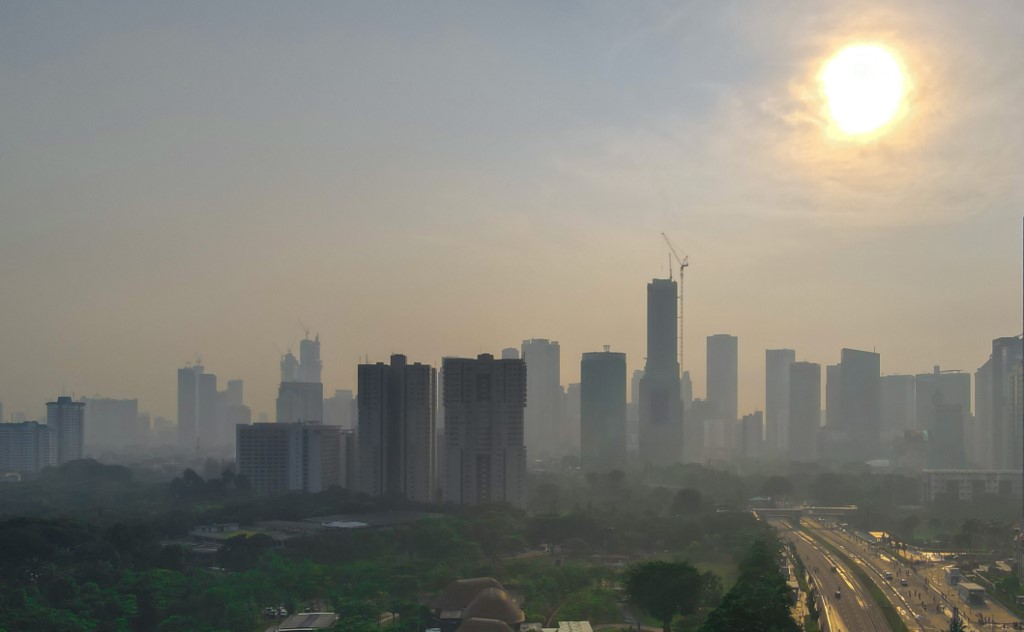
This aerial photo taken on June 13, 2021 shows buildings amid smog in Jakarta. (Photo by BAY ISMOYO / AFP)
 SINKING, polluted, crowded – people have been repeatedly reminded that Jakarta is no longer suitable to be the capital of Indonesia in the face of these radical challenges.
SINKING, polluted, crowded – people have been repeatedly reminded that Jakarta is no longer suitable to be the capital of Indonesia in the face of these radical challenges.
The capital is considered the world’s most rapidly sinking city, largely due to excessive groundwater extraction. It is predicted that around 25% of the capital area will submerge in seawater by 2050. At the same time, Jakarta is suffering from severe pollution.
Jakarta Health Agency reported that the city only had seen two days with ‘healthy’ air throughout 2019. To make matters worse, Jakarta, already – the largest city by population in Southeast Asia – maintains a rapid population growth. Passing the 10-million mark in 2020, the city is just getting more and more crowded.
The imaginary city of Nusantara in Kalimantan has now become the nation’s new hope to address all the sustainability issues in one go – building a completely new city that, hopefully, will not inherit any of these challenges.
The province that will house the new capital, East Kalimantan, is largely covered with vast old-growth forests. With the nickname ‘Nagara Rimba Nusa’, the city is frequently portrayed as a ‘green’ metropolis surrounded by rainforests with rich biodiversity, a clean city powered by renewable energy, and at the same time an innovation hub that houses hi-tech transportation, education, healthcare systems, etc.
Nusantara will not be the first capital city that is built from scratch. Around the world, there have been a number of capitals that are specially designed and developed. While in some cases the relocation happened within the existing metropolitan area (e.g., from Kuala Lumpur to Putrajaya), many of these new capitals are located far from the old capitals. They may offer the designers of Nusantara some important insights into sustainable city building.
Congestion is often cited as a major motivation for capital relocation. However, the problem may simply be brought along to the new capital.
One prominent example is Abuja, the purpose-built capital of Nigeria. In the 1980s, the country decided to develop a new city to replace the overcrowding Lagos as its new capital.
Abuja has since been experiencing rapid population growth for several decades and was once the world’s fastest-growing city in the 2000s. The total urban population is estimated to be around 3 to 4 million by 2020 and is still growing due to both migration and a very high birth rate, although the city was originally planned to house only 3 million people. Abuja now shares a similar challenge with Jakarta – the city is full of overcrowded slums.
Brasilia, the capital city of Brazil, is another case of a planned city that went wrong in terms of population management and urban planning. Founded in 1960, the city was named a Unesco World Heritage Site in the late 1980s. Similar to Nusantara, it was hoped that the construction of Brasilia as the nation’s new capital may bring progress to the interior of Brazil.
However, the idealised design for the city has created dozens of practical challenges. A fundamental problem is that it does not give enough space to the 2 million working class that cannot afford shelters in Plano Piloto, i.e., the city centre. As a result, it hardly can escape from the proliferation of slums and the accompanying problems. Furthermore, the commuting needs of these people were largely neglected with a poorly designed transportation system.
In contrast to Abuja and Brasilia, Naypyidaw, the city that replaced Yangon as the capital of Myanmar, is described by many as an ‘abandoned’ city. Naypyidaw is located about 320 kilometres north of Yangon.
It officially became the capital city in 2005, although at that time it only had a handful of buildings for government officials, with most facilities only gradually constructed in the following years. The population density remains extremely low for a capital – merely 130 per square kilometre. As a comparison, DKI Jakarta has a population density of about 16,000 per square kilometre. Today, Yangon remains the largest city and the economic centre of the country.
Another planned capital with a relatively low population density is Nur-Sultan in Kazakhstan created in 1997. The city on the banks of the Ishim River is described by some as the ‘weirdest capital’ in the world due to its location and its futuristic buildings.
Previously known as Astana, the city is surrounded by a vast, flat barren grassland that barely has any trees, not to mention other human settlements. With meticulously designed and science-fiction-like buildings sprouted from an empty patch of land, the city is considered by many to lacking an ‘organic’ sense but looking more like a showcase.
Although it has generally received a better reputation than the aforementioned examples, it is hard to tell how the heavy investment in building the new capital actually benefits the people, particularly the large population living outside Nur-Sultan.
The aforementioned cases, just like cautionary tales, supply useful lessons to Nusantara. Although the idea of building a future-oriented city in ‘clean’, ‘green’, and ‘hi-tech’ in the dense forest in Kalimantan may seem utopian, the Nusantara project remains the centrepiece of Indonesia’s development narrative.
In addition to a better physical environment, the construction of the capital gives hope for Indonesians, who have been troubled with poor governance and corruption, to re-dreaming a society that is safe, healthy, and just, as depicted in the Sustainable Development Goal 11 – ‘make cities and human settlements inclusive, safe, resilient and sustainable’.
Particularly, the people of Borneo are sensitive to the trade-off between economic development, environment, and social justice. There are worries that priority will be given to urban development at the expense of the environment and the rights of local communities.
One question that has tantalised the Bornean people is: Will the government of Indonesia handle the delicate Nusantara project with great care and ensure a smooth transformation? The development-environment dilemma may remain at the centre of regional development conversations throughout the decade, constantly entangled with various social issues like migration, poverty, equity, health, education, etc. Closer observation and analyses are needed to follow and understand both the local impacts and regional influences brought by the construction of Nusantara in the coming years.
*Dr Goh Chun Sheng is currently the Programme Leader for Master in Sustainable Development Management at Sunway University. He is also an Associate of the Harvard University Asia Center. Chun Sheng’s research interests lie within the intersection of bio-economy development and environmental restoration, with a special focus on both Malaysian and Indonesian Borneo. The most recent work by Chun Sheng is a monograph on Borneo, namely ‘Transforming Borneo: From Land Exploitation to Sustainable Development’, which will be published in late 2022.
